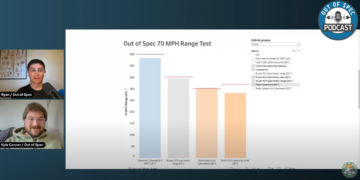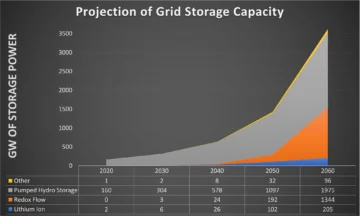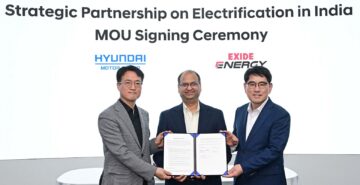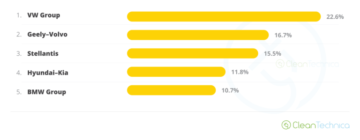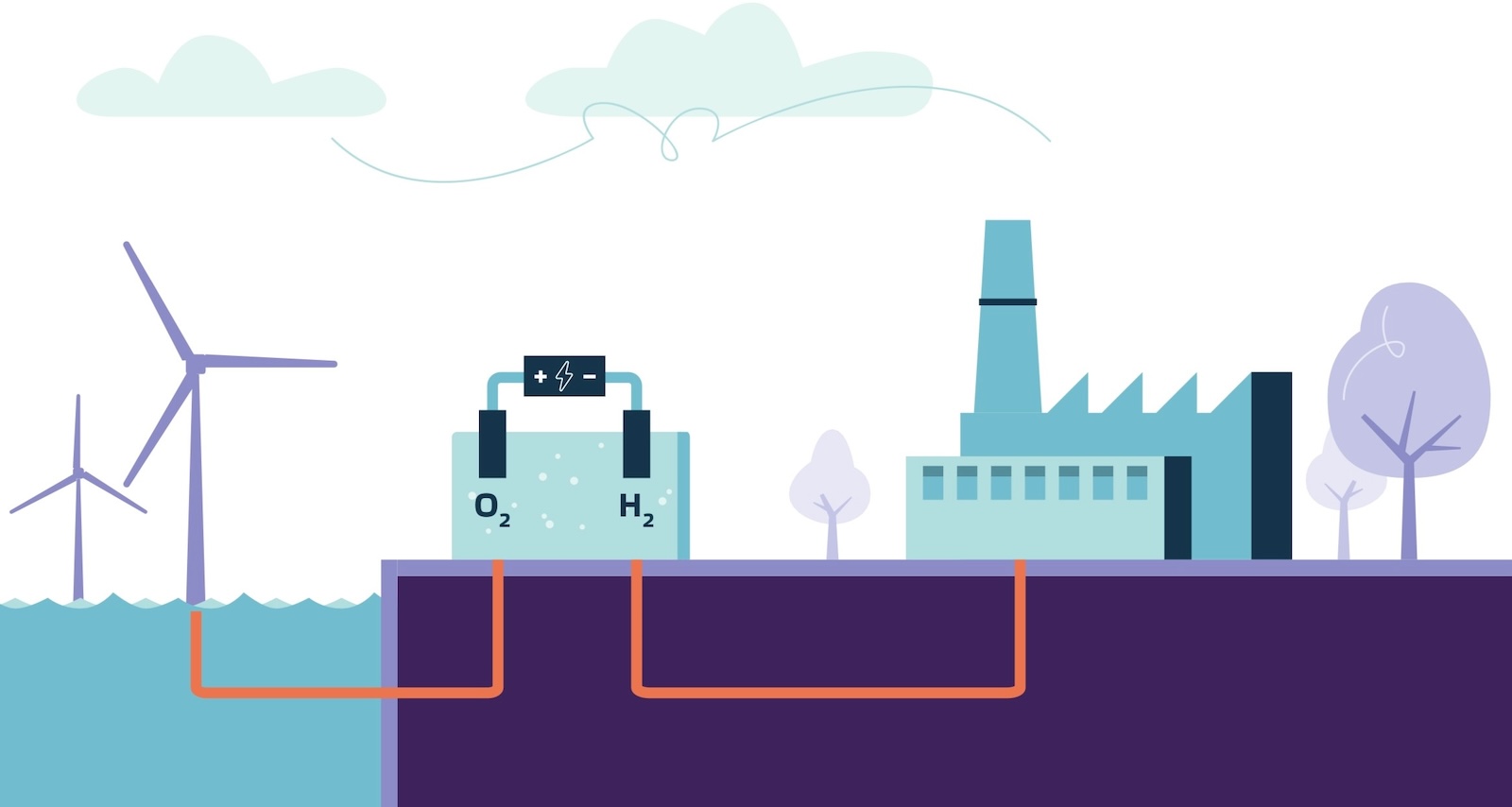
Sign up for daily news updates from CleanTechnica on email. Or follow us on Google News!
The back-and-forth debate over green hydrogen took another turn this week, when news broke that Mitsubishi is putting up $690 million to help build the world’s biggest green hydrogen plant, to be located in the Netherlands. It’s a whopper, all right. The new plant will be far bigger than any other conceived to date. More importantly, it will help patch up some holes in the energy independence plan of Europe, where Russian gas has been clinging to a foothold despite sanctions.
How Big Can Green Hydrogen Go?
As reported by Nikkei Asia over the weekend, the Japanese trading firm “Mitsubishi Corp. looks to invest over 100 billion yen ($690 million) to build one of the world’s largest ‘green’ hydrogen production plants in the Netherlands.”
Nikkei Asia reports that the “plant’s envisioned capacity of 80,000 tonnes annually would be nearly 30 times greater than that of the world’s largest facility now in operation.”
Thirty times greater — that’s a lot of green hydrogen! Hydrogen crosses the CleanTechnica radar mainly in the form of a fuel for fuel cell electric vehicles, but it is a ubiquitous industrial input that also shows up in food systems, oil refining, and metallurgy in addition to pharmaceuticals, toiletries and other products.
The global economy leans mainly on hydrogen extracted from natural gas at present, but the plunging cost of wind and solar power has stirred activity in the field of electrolysis, in which electricity is deployed to push hydrogen from water.
Thirty times the output of the next-biggest plant in operation may be a bit of an understatement. Last summer, Hydrogen Insight took note of the Kuqa electrolyser plant in Xinjiang, China, which it described as the biggest such facility in the world.
A project of the Chinese oil company Sinopec, the 260-megawatt plant began operating last summer with an initial output of 10,000 tons per year, eventually ramping up to 20,000 tons when fully operational.
Doing the math, 80,000 tons is not 30 times bigger than 20,000 tons. However, in terms of the Kuqa facility there’s a catch. Hydrogen Insight further reported that 58% of the electricity for the plant’s 52 electrolysers will come from a new solar farm, but the remaining 42% appears to rely on grid-supplied electricity, which presumably means that coal power plants are in play.
If that doesn’t sound particularly green, it isn’t. CleanTechnica is among those reserving “green hydrogen” to refer to electrolyzers that run primarily on wind, solar, and other renewables. Coal does not make the cut.
100% Renewable Energy For Sustainable Hydrogen
The new electrolyzer plant comes under the umbrella of Eneco Diamond Hydrogen, a joint venture between Mistubishi and the Dutch firm Eneco. Dubbed “Eneco Electrolyzer,” the 800-megawatt project is aimed initially at decarbonizing gas-dependent industries that are difficult to electrify directly. Instead, the electricity is stored, carried, and used in the form of green hydrogen.
The plan is to deploy both wind and solar power to keep the electrolyzers humming along.
“When direct electrification is not possible, green hydrogen is a good and sustainable alternative, both as a raw material and as a fuel,” explained Eneco CEO As Tempelman in a press statement last November.
Beyond its initial use in industrial processes, Eneco also foresees a market in the power generation industry. That may seem a bit counter-intuitive, since wind and solar are already available to run power plants. However, the idea is that green hydrogen is store-able and transportable, which would help build more resilience and flexibility into the electricity supply.
Who’s Gonna Pay For All This?
The hurdle facing the rapid uptake of green hydrogen is cost, cost, and more cost. The US Department of Energy currently uses $5.00 per kilogram as a rule of thumb towards a 2030 goal of $1.00 per kilogram. That’s a sharp contrast with natural gas, which the International Energy Agency pegs at a high of about $1.70, depending on the region.
It remains to be seen when and if the Eneco Electrolyzer can compete head-to-head with natural gas, but the location of the new facility could help. The new green hydrogen plant will be located at the existing Enecogen power station in Europoort, in Rotterdam.
“This location means the two facilities can share some infrastructure, which has advantages with regards to costs and realisation time,” Eneco explains.
Don’t get too excited just yet. As of November, Eneco was still in the process of submitting its planning application, so it’s not set in stone. Still, if all goes according to plan, construction will begin in 2026, with operation expected in 2029.
The clock is already ticking. Eneco’s “One Planet Plan” sets a 2035 climate-neutral goal for both Eneco and its customers.
“In addition, the Netherlands and Europe have set targets for the production of green hydrogen,” Enoco explains. “The Netherlands, for example, intends to increase green hydrogen production capacity to 4 gigawatts by 2030.”
Plugging Up The Natural Gas Leaks
That brings us to the situation in Europe, where Russia’s murderous rampage through Ukraine has provided ample motivation for the continent to stop depending on natural gas imported from Russia. Despite a series of sanctions packages, that has been a mixed success.
On December 31 last year, Radio Free Europe reporter Elitsa Simeonova reported that “While some countries ‘have significantly decoupled from Russia when it comes to energy, others — such as Hungary, Slovakia, and Austria — are still dependent on Russian gas and are not ready to change for both political and economic reasons.”
“…cutting Russia out of the energy equation completely will be much harder to achieve across a divided EU, where countries not only have very different energy needs but very different relationships with the Kremlin,” Simeonova added.
Simeonova takes a deep dive into the political situation and pipeline infrastructure that has kept Russian gas flowing to Europe. Somewhat ironically, that includes a pipeline transportation corridor from Russia to Europe, through Ukraine.
She also notes that, while Russian pipeline exports to the EU have decreased since the war began, LNG (liquid natural gas) exports have actually increased. The reason is fairly straightforward: The sanctions against Russian gas have yet to cover LNG.
“Not subject to EU sanctions, imports of Russian LNG, mostly via tankers, jumped 40 percent in the period between January and July 2023 compared to the prewar levels, Simeonova reported, citing the environmental watchdog Global Witness.
The Ukrainian clean power organization Razom We Stand further underscored the LNG loophole in a statement on January 15, linked to the 2023 World Economic Forum in Davos, Switzerland this week.
“Sustainable peace in Ukraine and worldwide relies on a crucial shift away from dependence on Russian oil and gas, steering towards a clean energy future,” said the founder and Director of Razom We Stand, Svitlana Romanko.
“Razom We Stand urges immediate action, including a ban on Russian LNG imports in Europe and the collective severance of reliance on Russian imports,” she added.
Romanko also noted that Ukraine’s existing gas storage infrastructure could help offset the impact of a ban on Russian LNG. That doesn’t necessarily mean natural gas, at least not over the long term. Ukraine’s plans for post-war recovery include contributing its vast wind and solar resources to support exports of green hydrogen to Europe.
CleanTechnica first took note of the Ukrainian renewable H2 project in the summer of 2022. It was still on track last year, apparently with the idea of repurposing the existing Russian gas transportation corridor for transporting green hydrogen.
Follow me @tinamcasey on Bluesky, Threads, Post, and LinkedIn.
Image: World’s largest green hydrogen electrolysis facility planned for the Netherlands, using wind and solar power (courtesy of Enoco).
Have a tip for CleanTechnica? Want to advertise? Want to suggest a guest for our CleanTech Talk podcast? Contact us here.
Our Latest EVObsession Video
[embedded content]
I don’t like paywalls. You don’t like paywalls. Who likes paywalls? Here at CleanTechnica, we implemented a limited paywall for a while, but it always felt wrong — and it was always tough to decide what we should put behind there. In theory, your most exclusive and best content goes behind a paywall. But then fewer people read it!! So, we’ve decided to completely nix paywalls here at CleanTechnica. But…
Thank you!
Advertisement
CleanTechnica uses affiliate links. See our policy here.
- SEO Powered Content & PR Distribution. Get Amplified Today.
- PlatoData.Network Vertical Generative Ai. Empower Yourself. Access Here.
- PlatoAiStream. Web3 Intelligence. Knowledge Amplified. Access Here.
- PlatoESG. Carbon, CleanTech, Energy, Environment, Solar, Waste Management. Access Here.
- PlatoHealth. Biotech and Clinical Trials Intelligence. Access Here.
- Source: https://cleantechnica.com/2024/01/15/worlds-largest-green-hydrogen-plant-eu-russia-natural-gas-imports/
- :has
- :is
- :not
- :where
- $UP
- 000
- 10
- 100
- 15%
- 20
- 2022
- 2023
- 2026
- 2030
- 30
- 31
- 36
- 40
- 70
- 80
- a
- About
- According
- Achieve
- across
- Action
- activity
- actually
- added
- addition
- advantages
- Advertise
- Affiliate
- against
- aimed
- All
- along
- already
- also
- alternative
- always
- among
- an
- and
- Annually
- Another
- any
- appears
- Application
- ARE
- AS
- At
- Austria
- available
- away
- Ban
- BE
- been
- began
- begin
- behind
- BEST
- between
- Big
- bigger
- Biggest
- Billion
- Bit
- bluesky
- both
- Brings
- Broke
- build
- but
- by
- CAN
- Capacity
- carried
- Catch
- cell
- ceo
- change
- China
- chinese
- chip
- citing
- clean
- clean energy
- cleantech
- Cleantech Talk
- Clock
- Coal
- Collective
- come
- comes
- Companies
- company
- compared
- compete
- completely
- conceived
- construction
- content
- continent
- contrast
- contributing
- Corp
- corridor
- Cost
- Costs
- could
- countries
- cover
- crucial
- Currently
- Customers
- Cut
- Date
- davos
- debate
- December
- decide
- decided
- decreased
- deep
- deep dive
- Department
- Department of Energy
- dependence
- dependent
- Depending
- deploy
- deployed
- described
- Despite
- Diamond
- different
- difficult
- direct
- directly
- Director
- dive
- divided
- does
- Doesn’t
- don
- dubbed
- Dutch
- Economic
- Economic Forum
- economy
- Electric
- electric vehicles
- electricity
- electricity supply
- embedded
- energy
- environmental
- envisioned
- EU
- Europe
- eventually
- example
- excited
- Exclusive
- existing
- expected
- explained
- Explains
- exports
- facilities
- Facility
- facing
- fairly
- far
- farm
- felt
- fewer
- field
- Firm
- First
- Flexibility
- Flowing
- food
- foothold
- For
- form
- Forum
- founder
- Free
- from
- Fuel
- fully
- further
- future
- GAS
- generation
- get
- Global
- Global economy
- Go
- goal
- Goes
- good
- greater
- Green
- Guest
- harder
- Have
- help
- here
- High
- Holes
- However
- HTML
- HTTPS
- Hungary
- hurdle
- hydrogen
- idea
- IEA
- if
- immediate
- Impact
- implemented
- importantly
- imports
- in
- include
- includes
- Including
- Increase
- increased
- independence
- industrial
- industries
- industry
- Infrastructure
- initial
- initially
- input
- instead
- intends
- into
- Invest
- Ironically
- IT
- ITS
- January
- Japanese
- joint
- joint venture
- jpg
- July
- just
- Keep
- kept
- Kremlin
- largest
- Last
- Last Year
- latest
- least
- levels
- like
- likes
- Limited
- linked
- links
- Liquid
- lng
- located
- location
- Long
- LOOKS
- loophole
- Lot
- mainly
- make
- Market
- material
- math
- May..
- me
- mean
- means
- Media
- million
- mixed
- more
- most
- mostly
- Motivation
- much
- Natural
- Natural Gas
- nearly
- necessarily
- Need
- needs
- Netherlands
- New
- news
- note
- noted
- Notes
- November
- now
- of
- offset
- Oil
- Oil and Gas
- on
- only
- operating
- operation
- operational
- or
- organization
- Other
- Others
- our
- out
- output
- over
- packages
- particularly
- Patch
- Pay
- peace
- People
- per
- percent
- period
- pharmaceuticals
- pipeline
- plan
- planet
- planned
- planning
- plans
- plant
- plants
- plato
- Plato Data Intelligence
- PlatoData
- Play
- player
- plunging
- podcast
- policy
- political
- possible
- Post
- power
- power plants
- present
- press
- primarily
- process
- processes
- Production
- Products
- project
- provided
- publish
- Push
- put
- Putting
- radar
- ramping
- rapid
- Raw
- Read
- Reader
- ready
- reason
- reasons
- recovery
- refer
- refining
- regards
- region
- Relationships
- reliance
- rely
- remaining
- remains
- Renewable
- renewable energy
- Renewables
- replace
- Reported
- reporter
- Reports
- resilience
- Resources
- right
- Rule
- Run
- Russia
- russian
- Russian gas
- Russian oil
- Said
- Sanctions
- see
- seem
- seen
- Series
- set
- Sets
- Share
- sharp
- she
- shift
- should
- Shows
- significantly
- since
- situation
- So
- solar
- Solar Power
- some
- somewhat
- Sound
- stand
- Statement
- station
- steering
- Still
- STONE
- Stop
- storage
- stored
- Stories
- straightforward
- subject
- success
- such
- suggest
- summer
- supply
- support
- sustainable
- switzerland
- Systems
- T
- takes
- Talk
- targets
- team
- term
- terms
- than
- that
- The
- the Netherlands
- the world
- then
- theory
- There.
- this
- this week
- those
- Through
- ticking
- time
- times
- tip
- to
- tons
- too
- took
- tough
- towards
- track
- Trading
- transportation
- transporting
- TURN
- two
- ubiquitous
- Ukraine
- Ukraines
- Ukrainian
- umbrella
- under
- Updates
- uptake
- urges
- us
- use
- used
- uses
- using
- Vast
- Ve
- Vehicles
- venture
- very
- via
- Video
- want
- war
- was
- watchdog
- Water
- we
- week
- weekend
- What
- when
- which
- while
- WHO
- will
- wind
- with
- witness
- world
- World Economic Forum
- world’s
- worldwide
- would
- write
- Wrong
- year
- Yen
- yet
- you
- Your
- youtube
- zephyrnet

